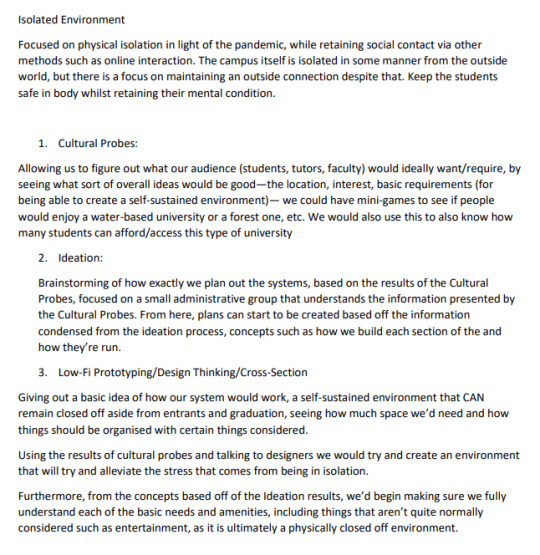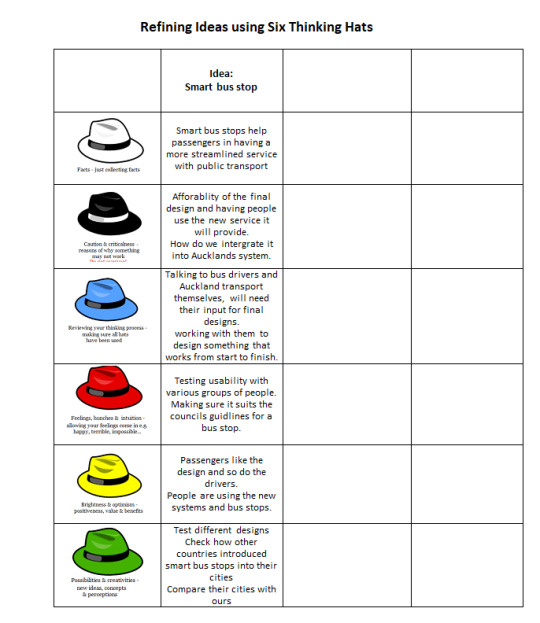Don't wanna be here? Send us removal request.
Text
Week 11 - Design challenge

For today exercise we had to use methods we have tested this year in Integrative Practice to pitch a strategy on how to build the perfect university. We first went with Cultural Probes, as this is a effective way of gathering feedback from would be users, from what location would suit people best and what their basic needs are.
Secondly we Ideated by brainstorming aspects of the university based on what we would receive from conducting the cultural probe, as it would make a great staring point for future designs and prototyping.
Lastly we would start building the prototype by first sketching the designs and cross sectioning them, these would serve as a way to gather feedback, from that feedback we would then start creating lo-fi prototypes of the university. These prototypes would be an accurate visual to further gather feedback.
0 notes
Text
Week 10 - Systems thinking
1. How could you use systems thinking in your creative processes?
I found that using systems thinking was really helpful in visualising certain aspects of something, and what the positives and negatives are and how they all intergrade work together. I would use this method as another way to visualise my ideas, and show how they all work together.
2. How could this method complement (or contrast) another method we have explored in CTEC500?
A great method I think that would complement systems thinking is the lotus flower diagram, as you could plan out aspects with the lotus flower diagram, and then pin them up on loopy and mark out how they would all work together.

0 notes
Text
Week 9 - Wallet







I presented this prototype to my girlfriend/
What did they like?
What they like about the design is that it can protect whatever is inside it, and make them last longer.
What would they change?
She would change the material it is made out of as my idea was to make it out of metal and that would be too heavy.
Any questions?
If this was to be used to store photographs, how many could it fit?
Any ideas?
She a great idea on what material to make it out of, there is a material called Tyvek, it is a light, durable, water resistant paper-like material, I believe it would be the perfect material to make this product with, as it’s cheaper and lighter than metal, and hard enough to protect the things that are stored within it.

0 notes
Text
Week 7 - Sectional Drawing

This weeks exercise had me cut an object in half and sketch 2 perspectives of it, my object was an Oreo cookie, I drew a side view and another on an angle, then I made a cross section of it on its side and roughly sketched it as if it was a building of some sort, looking at these objects as a basis of a design would be a great way to find a starting point for a design where I have no idea on how something would look.
1. Consider how you use drawing as a research method in your own work and tell us about that – it could be quite unlike any of the ways we have talked about in this class - maybe you make diagrams or maps to explain your ideas?
During my studio project I made many sketches of the design of the artefact and how the digital interfaces would work, and how they would work together, I have always found drawing is a lot easier at describing something than using words, and using both together is an even better way to convey an idea.
2. How might you use drawing in other ways in your work?
I find drawing something more memorable than writing something, so sometimes I may draw a reminder rather than write it out, or as a way to capture an idea or design in my head.
0 notes
Text
Week 6 - Refining ideas


1. In what ways did this exercise assist you in creative thinking and generating ideas?
It helped in planning a way to tackle certain aspects of my studio project by finding what problems to sort out first and how, and also it helped in planning for future designs as it gave me a way of thinking about them.
2. How might you use or adapt this method in future for your work?
In the future I would start by using this method to assist in planning out my designs, research and a way of gathering feedback from the group I’m designing for.
0 notes
Text
Week 5 - Lo Fi Prototypes

This weeks exercise was making some lo fi prototypes to spark ideas to fill empty spaces in Fort Lane in the CBD, with paper scraps from an old paper bag I made a sail to block the rain or sun from above as there was no shade on the stretch of road, also I made a sculpture of a metal plant to complement the modern city and to give a sense of nature, and I designed a basic rubbish bin as I saw no public bins, and a simple bench as there was no seating.
1. Describe how this ideas could be deployed. There are no limits! Choose any materials or technologies.
I made a rough mock up of how the set would look in Fort Lane itself, I would likely construct this with a metallic material to better suit the environment of Fort Lane.

2. How did engaging with your ideas in three dimensions (through prototypes) help you better understand your designs?
It helped in quickly making a design go from a sketch into something psychical in the most painless and affordable way possible, and helped me visualise better in how I could make the design work in a psychical space, and how people would interact with it.
0 notes
Text
Week 4 - material interrogations
1. Describe your selected object and why it is significant to you.
My object was a soft plushie of the Pokémon Umbreon, first introduced in Pokémon Silver on the Gameboy Colour, this was one of the first videogames I played growing up and is my favourite Pokémon from the generation.

2. Provide a sequence timeline of all of the creative processes conducted with the material interrogations method with visual documentation, associated notes and explanations of each process and outcome.
I used Photo Moshed and the glitch the image once then saved then glitched the new image, then repeated that 10 times, this way I was able to overlap the same effects multiple times.

I then loaded the raw data of the image into Audacity and screen grabbed the wave image and moshed it into a gif
I then distorted the cry of Umbreon and layered it over the gif and exported it as an MP4
youtube
3. Reflective Paragraph: Write/Vlog/Voice Record about the learning gained from engaging in the method of material interrogations in regards to your own way of creative thinking and making and how might you apply this method within your developing practice in the future.
It was a great learning experience by breaking the mould and creating something from something simple as a picture, it helped me realise that there isn’t always a clear progression to ones creative process, and that sometimes the most beautiful things a made randomly or by accident. Possibly in the future I wouldn’t use this method as part of a process, only if it was the start of one, to just spit out designs.
0 notes
Text
Week 3 - Sounding the City
For this exercise I was tasked in recording the sounds of certain places in the Auckland CBD and describe them with an onomatopoeia.
1. Describe all the sounds you could hear in the soundscape (Don’t just name objects!). Use onomatopoeia to help you describe them.
2. How – through design or technology – could you make that space sound different?
3. What effect would your sonic re-design have on people’s experience of that space?

1. Whistling through the halls of the art gallery
2. Using a windpipe art installation at the entrance would turn the sound of the wind into a work of art, an impressive display as people enter the art gallery.
3. Having something that eliminates the intrusive sound that also adds the the scene of an art gallery would greatly improve the experience people would have.

1. Sounds of someone putting up a sign
2. The lack of music that plays in Aotea Square allows intrusive sounds from construction around the city invade the soundscape of the Square, so maybe simple like just having some music installations around would help drown out the sound.
3. Having somewhere musical to chill in the city would be nice, especially if it’s somewhere open like Aotea Square.

1. Construction site machinery going
2. An idea my group had for this soundscape was a sort of tarpaulin that wraps around the building to mask the sounds, something similar to noise dampening foam.
3. If someone was able to create a technology like this it would greatly reduce sound pollution in large cities that have large amount of construction happening.
0 notes
Text
Week 2 - Cultural Probes
In this week's exercise we were given an scenario where we were a research group trying to gather information from local farmers on how they would be open to idea of using drones on their farms, rather than asking questions we presented a diorama as a visual aid to represent how saving time with a drone will give them more free time.
1. What do you think might be one issue in working with Cultural Probes as a method?
One issue that may arise from this is the moral implication that you may face when probing certain groups of people, for example if someone was probing disabled people and wasn’t careful how they asked their questions, there could be an issue there.
2. Write about a situation where you might use Cultural Probes as a method to understand a group of people?
I actually used this method when I approached bus drivers concerning my studio project, rather than telling them about the design we were working on, I asked them about issues they faced when picking up passengers.



0 notes
Text
Week 1 - Walking as a research method
In today's class coming back from break, and our first in uni class since the lock down we tried an activity where we walked around the uni and at certain intervals we stopped a drew something below us.
1. In what ways did this exercise assist in seeing things you may have not have noticed before?
The ways this exercise assisted me in seeing things I may have not noticed before were that walking around aimlessly was in ways freeing, in that not having a particular destination helped me focus on what I normally don’t notice in my surroundings.
2. How might you use or adapt this method in future for your work?
The way I might adapt this method in the future might be just sketching ideas for a problem with no real goal, just throw ideas out there but keep a visual record.

With this exercise I learnt new ways to access my surroundings by taking notice of things I wouldn’t see otherwise, looking for particular objects or scenery helped me narrow down my perception and made me focus, in the future I may use this to pick out details in a design that I wouldn’t normally take notice of and take that and improve on it.

0 notes